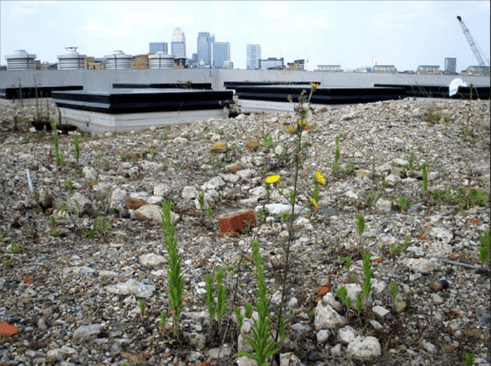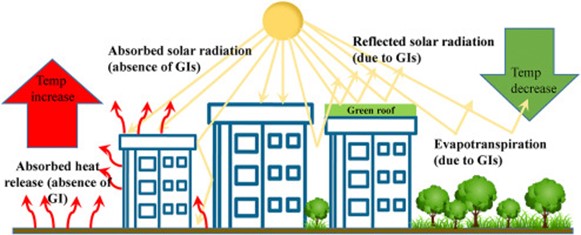Imagine, that you are taking care of a green space around your house or in a park. Will you put the sole substrate on the ground and watch it regrow on its own, observe which invasive plants will burst the first ones? Probably not. You will either use prevegetated lawn mats or sow the lawn seeds – sometimes even cover the ground afterwards with a gardening membrane to warm up the top layer and prevent suparticles to be blown away, protect the seeds from wind erosion and birds, and protect the soiltop from weeds colonisation. Well, the similar principles apply with the rooftop surface.
Brown roof with uncertain outcome
Green is not brown and vice versa. What is a brown roof?
Rooftop that is waterproofed and substrate is added (soil and rubble from construction site) that mimics the brown-field site upon the which the building was constructed. It is then left for plants to self-colonise with help of wind or birds.
So far so good, one may say. But imagine such site after a season or two. Wind erosion will play the game and blow away the lightweight particles into surroundings. Do you want these particles to float freely in the neighbourhoods and increase dust particles concentration in the urban air? Do you want to have an exposed substrate-less roof spots afterwards, where plants will have no place to develop?
Even if you decide for brown roof, you will need to maintain it - often even more intensively than the green one. You will need to remove the unwanted weeds and the deep-rooted saplings. Both will likely have more space to root in and grow than in case of pre-vegetated green roof, where existing plants will compete with undesired “newcomers”. You will need to prune oversized plants and feed (only desired) plants. You will clean border areas, clean the gutters and drains. The latter are likely to be quickly clogged as you will have lots of freely moving substrate particles until the roof becomes vegetated.
You will likely have to do additional planting, as in case of Laban dance centre brown roof, where most of the plants have been collected locally and planted over the years on a brown roof, as reported by recognised green infrastructure professional mr. Dusty Gedge (https://dustygedge.co.uk/index.php/green-roofs/laban-the-story-of-the-original-rubble-brown-roof/ ).

Photo: Laban dance center brown roof (https://www.researchgate.net/figure/Laban-Dance-Centre-brown-biodiverse-roof_fig6_265937139)
All types of »biodiverse« roofs require an investment. If you want to address the urban challenges with it responsibly means, you walk the talk and you don’t greenwash your stakeholders.
All the benefits, which are already widely recognised: urban heat island effect mitigation, energy efficiency, stormwater management and improved well-being…, will be better and more efficiently achieved with green roof than brown. Think about heat island effect mitigation. In case of brown roof, the rooftop surface is covered with a layer of substrate, which will heat and dry up. In case of a green roof, the surface is covered with dense vegetation layer. And plants are the miracle workers here. They evaporate, transpirate and cool down the surrounding air:

Source: Tiwari et al., 2021. (GI = green infrastructure)
What does science say about brown roofs? Brown roofs were initially thought as a self-colonization spot, where seeds would be brought, through the wind and birds, and were left as in a brownfield. The substrate was based on crushed concrete. The promoters of this concept have now put it aside due to its poor value in terms of storing and providing water, besides the unwanted vegetation that may appear and it can either give the impression of an unkempt system or it can damage the roof (Calheiros and Stefanakis, 2021).
Why are green roofs becoing increasingly important?
Urban settlements (cities, towns, suburbs) house 55% of the world population and this proportion is projected to increase to 68% in 2050. Urbanization is related with the spatial distribution of the world population, being one of the four demographic mega trends, i.e., growth of the global population, population aging, and international migration.
Quality of life in urban settlements is and wll be in the future of outmost importance. The integration of nature-based solutions (NBS) and green infrastructure (GI) aims towards re-naturing the cities and increased territorial resilience. Role of NBS and GI has beeen acknowledged and is recognized also in recent policy orientation (UN Climate action summit, EU Green Deal, Nature restoration law, Biodiversity Strategy…) and many national incentives and grants around the globe. This development should be boosted further as a sustainable path into tomorrow's urban areas.
1. Green roof expansion is doable in policy terms
There are still big differences in green roof shares on city level, from 5,71 m2 of green roof per habitant in Suiss Basel down to 0,09 in Toronto, in Singapore and even 0,07 m2/inhbabitant in Copenhagen (Chapman, 2019).
The challenge is to transform the built environment through the inclusion of NBS. Taking advantage of the existing space in the top of the buildings, the integration of green roofs will support the cities’ transition towards circularity and resilience. They provide several ecosystem services and can act as multifunctional and decentralized units. In order to boost these services, green roofs need to be effectively incorporated and replicated in the urban landscape (Calheiros and Stefanakis, 2021). Why shall indeed policy talk daily and specifically about green roofs and not just mention it as part of NBS and GI?
Because:
- 40 – 50% of the impermeable surface area in most developed cities, is attributed to the roofs (Stovin, 2010).
- it is possible to install green roofs on retrofitted roofs (lightweight green roofs such as Urbanscape) and to mandate green roofs on new buildings
- the green roofs significantly increase the performance of solar panels (sklic manjka) and thus contribute to efficient renewable energy resources usage
Current EU policy within framework of a Green deal indicates the numerous possibilities for policy makers interventions within legislative files under revision (WGIN, 2023):

2. Green roofs provide increasingly important benefits in urban environment
Interesting figures by Quaranta et al. (2021), shown that greening of 35% of the EU’s urban surface (i.e. more than 26,000 km2) would avoid up to 55.8 Mtons year−1 CO2 equivalent of greenhouse gas emissions, reducing energy demand for the cooling of buildings in summer by up to 92 TWh per year, with a net present value (NPV) of more than 364 billion Euro. It would also transpire about 10 km3 year−1 of rain water, turning into “green” water about 17.5% of the “blue” water that is now urban runoff, helping reduce pollution of the receiving water bodies and urban flooding.
The greening of urban surfaces would decrease their summer temperature by 2.5–6 °C, with a mitigation of the urban heat island effect estimated to have a NPV of 221 billion Euro over a period of 40 years. The monetized benefits cover less than half of the estimated costs of greening, having a NPV of 1323 billion Euro on the same period. Net of the monetized benefits, the cost of greening 26,000 km2 of urban surfaces in Europe is estimated around 60 Euro year−1 per European urban resident. The additional benefits of urban greening related to biodiversity, water quality, health, wellbeing and other aspects, might be worth such extra cost.
When this is the case, urban greening represents a multifunctional, no-regret, cost-effective solution.
Literature:
Calheiros C, and Stefanakis, A, 2021. Green Roofs towards Circular and Resilient Cities. Circular Economy and Sustainability 1, 395 – 411. 2021.
Chapman E, 2019. Greening roofs in Europe and beyond. Enable, ICLEI. Oslo, 2019.
Stovin, V, 2010. The potential of green roofs to manage urban stormwater. Water and Environment Journal 24:192-199. https://doi.org/10.1111/j.1747-6593.2009.00174.x
Tiwari A, et al., 2021. The impact of existing and hypothetical green infrastructure scenarios on urban heat island formation. Environmental Pollution Vol. 274, April 2021.
Quaranta E, Dorati C, Pistocchi A, 2021. Water, energy and climate benefits of urban greening throughout Europe under different climatic scenarios. Sci Rep 11, 12163 (2021).
WGIN, 2023. Urban Green Infrastructure for People and Climate: Synergies with EU Green deal & Fit for 55 Package. WGIN-brochure_rev11.pdf (worldgreeninfrastructurenetwork.org)


